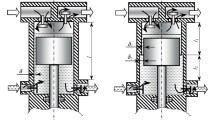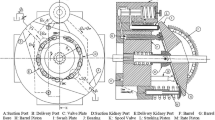The use of the liquid PES-3 in a high-pressure piston pair is modeled and the parameters of the piston pair are determined. Equations are derived for a mathematical model describing the variation of the pressure in the gap between the piston and cylinder. The distribution of the pressure in the gap between the piston and cylinder is calculated for piston pressures below 1.6 GPa. The profiles of the gaps between a deformed piston and the cylinder are calculated for different piston pressures and the dependences of the piston downstroke velocity and gap efficiency on the piston pressure are calculated for different gaps of the undeformed piston pair. The results of this study can be used for the design of piston pairs operating in PES-3 fluid at pressures ranging from 0.01–1.6 GPa.




Similar content being viewed by others
References
S. Dorga, S. Yadav, and A. K. Bandyopadhyay, Measurement, 43, No. 10, 1345–1354 (2010), https://doi.org/10.1016/j.measurement.2010.07.010.
S. Yadav, O. Prakash, V. K. Gupta, and A. K. Bandyopadhyay, Metrologia, 44, 222–233 (2007), https://doi.org/10.1088/0026-1394/44/3/009.
H. Kajikawa, K. Ide, and T. Kobata, Rev. Sci. Instrum., 80, No. 9, 095101–095110 (2009), https://doi.org/10.1063/1.3203150.
W. Sabuga, G. Molinar, G. Buonanno, et al., Metrologia, 43, No. 3, 311–325 (2006), https://doi.org/10.1088/0026-1394/43/3/015.
E. V. Zolotykh (ed.), High Pressure Studies, Izd. Standartov, Moscow (1987).
V. M. Borovkov, “Piston-load high-pressure manometers: mathematical modeling and construction of counter-pressure piston pairs,” Alm. Sovr. Metrol., No. 1 (17), 109–115 (2019).
V. M. Borovkov, D. I. Kuznetsov, S. S. Sekoyan, et al., “Creation of a national primary standard for the unit of pressure in the 10–1600 MPa range,” Izmer. Tekhn., No. 11, 7–10 (2014).
P. Vergne, HTHP, 22, No. 6, 613–621 (1990).
A. E. Aslanyan, “Deviations in the deformation of a piston and cylinder of a high-pressure piston pair with deformation calculated using a solution of the Lamé problem,” Metrologiya, No. 6, 20–25 (2011).
A. E. Aslanyan, Methods of Reducing the Unexcluded Systematic Component of the Error in the National Primary Special Standard for the Unit of Pressure GET 43-73: Auth. Abstr. Dissert. Cand. Techn. Sci., Mendeleevo (2012).
Author information
Authors and Affiliations
Corresponding author
Additional information
Translated from Izmeritel’naya Tekhnika, No. 10, pp. 38–42, October, 2020.
Rights and permissions
About this article
Cite this article
Aslanyan, A.E. Dependence of the Characteristics of a High-Pressure Piston Pair on the Properties of PES-3 Working Fluid and the Pressure Distribution in the Piston-Cylinder Gap. Meas Tech 63, 811–815 (2021). https://doi.org/10.1007/s11018-021-01857-w
Received:
Accepted:
Published:
Issue Date:
DOI: https://doi.org/10.1007/s11018-021-01857-w




